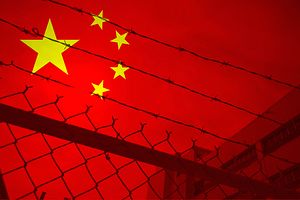By Andrew Samet
 There is understandable anguish about the human rights abuses being suffered by Muslim Uyghur and other ethnic communities in China’s Xinjiang region. The documentation of violations has grown more graphic over the last two years, while an international response remains largely indeterminate.
There is understandable anguish about the human rights abuses being suffered by Muslim Uyghur and other ethnic communities in China’s Xinjiang region. The documentation of violations has grown more graphic over the last two years, while an international response remains largely indeterminate.
Not so for the Trump administration, which has sanctioned Chinese officials and firms for complicity in the abuses, and also issued a warning to U.S. businesses that they, too, could face sanctions for sourcing goods from Xinjiang if tied to the widespread forced labor in the region.
To amplify the basis for these actions, National Security Adviser Robert O’Brien penned an op-ed on July 12 in which he referred to “the vast archipelago of camps where 1 million Uyghurs are undergoing “reeducation,” “thought transformation” and forced labor.” Secretary of State Mike Pompeo gave a July 23 speech and referred to Xinjiang’s “concentration camps.”
Many global companies are feeling the weight of the messaging that forced labor is a risk in their apparel, electronics, and automotive supply chains given potential links to production in Xinjiang or to workers forcibly moved from the region to factories elsewhere in China. A recent joint statement by several trade associations in Washington cautioned that while individual firms were committed to eradicate forced labor in their own supply chains, “a successful solution for all involved… will require state-to-state engagement and collaborative partnerships…”
In other words, the business groups argue, no firm or government acting on its own will stop forced labor and other human rights violations in Xinjiang. A broader effort is needed.
Meanwhile, Pascal Lamy, the former French and European Commission official, and former director general of the World Trade Organization, last week reportedly observed that, with regard to the EU’s response to forced labor in Xinjiang, “it is up to the International Labor Organization (ILO) and to the WTO, who both ban forced labor, to tackle this issue.”
Lamy’s comment implies a point not dissimilar to one reflected by the Washington trade associations: The criticism of the Trump administration that it has forsworn working with allied nations through international institutions on global challenges. The Trump administration, however, seems to regard U.N. agencies as compromised by China and ineffective – the WHO and the coronavirus being offered as Exhibit A. Xinjiang presents an important test of both critiques.
Based on my time representing the United States at the ILO, I have no doubt the organization’s mechanisms could and should be engaged on the labor rights violations in Xinjiang. Opposing forced labor is core to the ILO’s mandate and global responsibility. Uniquely of all U.N. agencies, the ILO has the capacity to act without consensus, or in this case agreement from China, since voting control is not held by governments, and certainly not by governments alone, but by trade union and employer association representatives.
Just last month at the U.N. Human Rights Council, China with support of 46 governments could push back a United Kingdom-led effort, supported by 27 governments, to seek access for the U.N. High Commissioner for Human Rights to the Xinjiang region. At the ILO, simply securing the support of a majority of governments would not allow China to block an investigation of labor conditions in Xinjiang. China would also need to be able to neutralize the votes of trade union and employer association representatives.
Those reluctant to have the ILO take up the Uyghur issue will likely point out China has not ratified the ILO’s forced labor conventions, and the supervisory mechanisms are invoked against a country for conventions it has ratified. True, but the ILO still has options.
Consider one: In 2006 China ratified ILO Convention 111 barring discrimination in employment. The ILO could investigate China’s compliance with this convention regarding the employment of ethnic Uyghurs and Kazakhs. This would permit a serious and detailed review of the labor violations against these communities.
Under Article 26 of the ILO Constitution, any of the EU governments, all of which have ratified ILO Convention 111, including Pascal Lamy’s France, could initiate the procedure. (The United States has not ratified Convention 111 — although it has been on the U.S. Senate’s treaty calendar since 1998 – so it could not. Maybe the Senate might want to consider finally acting on that convention now?) Employer and trade union delegates to the ILO could also initiate procedures challenging China’s compliance with Convention 111 since different rules apply to them.
Using this procedure, the ILO can establish a Commission of Inquiry that gathers evidence, hears testimony, and issues a public report detailing its findings and recommendations. The failure of a member state to implement such recommendations can lead to a decision by the ILO to authorize sanctions by member states, as happened in the case involving forced labor in Myanmar in 2000.
This is only one example of how the ILO could express its concern on Xinjiang – there are others. Of course, ILO action would not be a sufficient global response to the suffering in Xinjiang, but it would at least be a response — and whether the ILO defends the Uyghurs will tell us a great deal about U.N. agencies and their relationship to China.
Andrew Samet is a former U.S. representative to the governing body of the ILO during the Clinton administration, and participated in the establishment of an ILO Commission of Inquiry to investigate forced labor in Myanmar.
No comments:
Post a Comment